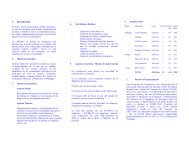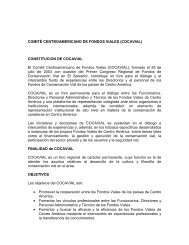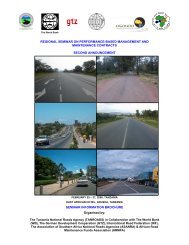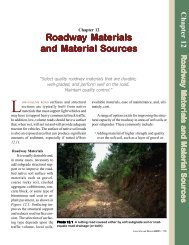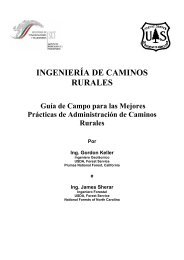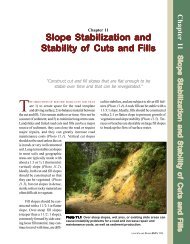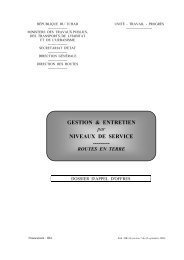Create successful ePaper yourself
Turn your PDF publications into a flip-book with our unique Google optimized e-Paper software.
Table 7.1<br />
Recommended Maximum Distance Between Rolling Dip<br />
or Culvert Cross-Drains (meters)<br />
<strong>Low</strong> to<br />
Road Grade % Non-Erosive soils (1) Erosive Soils (2)<br />
Table le 7.2<br />
0-3 120 75<br />
4-6 90 50<br />
7-9 75 40<br />
10-12 60 35<br />
12+ 50 30<br />
Recommended Water Bar Spacing (meters)<br />
Road/Trail <strong>Low</strong> to<br />
Grade % Non-Erosive soils (1) Erosive Soils (2)<br />
0-5 75 40<br />
6-10 60 30<br />
11-15 45 20<br />
16-20 35 15<br />
21-30 30 12<br />
30+ 15 10<br />
Note: (1) <strong>Low</strong> Erosion Soils = Coarse Rocky Soils, Gravel, and<br />
Some Clay<br />
(2) High Erosion Soils = Fine, Friable Soils, Silt, Fine<br />
Sands<br />
Adapted from Packer and Christensen (1964)<br />
& Copstead, Johansen, and Moll (1998)<br />
ditches and cross drains. It is difficult<br />
to create and maintain a<br />
crown on a narrow road, so generally<br />
insloped or outsloped road<br />
drainage is more effective for rural<br />
roads.<br />
Culvert cross-drains are used<br />
to move ditch water across the<br />
road. They are the most common<br />
type <strong>of</strong> road surface drainage, and<br />
are most appropriate for highstandard<br />
roads where a smooth<br />
road surface pr<strong>of</strong>ile is desired.<br />
However the pipes are expensive,<br />
and the relatively small culvert<br />
pipes used for cross-drains are<br />
suseptible to plugging and require<br />
cleaning.<br />
Rolling dip cross-drains<br />
(broad-based dips) are designed<br />
to pass slow traffic, while also dispersing<br />
surface water (Photo 7.2).<br />
Rolling dips usually cost less, require<br />
less maintenance, and are<br />
less likely to plug and fail than<br />
culvert pipes. Rolling dips are<br />
ideal on low volume, low to moderate<br />
speed roads (20-50 kph).<br />
Spacing is a function <strong>of</strong> road<br />
grade and soil type, as seen in<br />
Table 7.1. Other types <strong>of</strong> roadway<br />
surface cross-drain structures occasionally<br />
used include open top<br />
wood or metal flumes, and rubber<br />
water deflectors.<br />
Steep road grades are undesirable<br />
and problematic, but occasionally<br />
necessary. On grades up<br />
to 10%, cross-drains with culverts<br />
or rolling dips are easy to use. Between<br />
10 and 15%, frequently<br />
spaced culvert cross-drains work,<br />
<strong>of</strong>ten in conjunction with armored<br />
ditches. On grades over 15%, it<br />
is difficult to slow down the wa-<br />
LOW-VOLUME ROADS BMPS : 55



